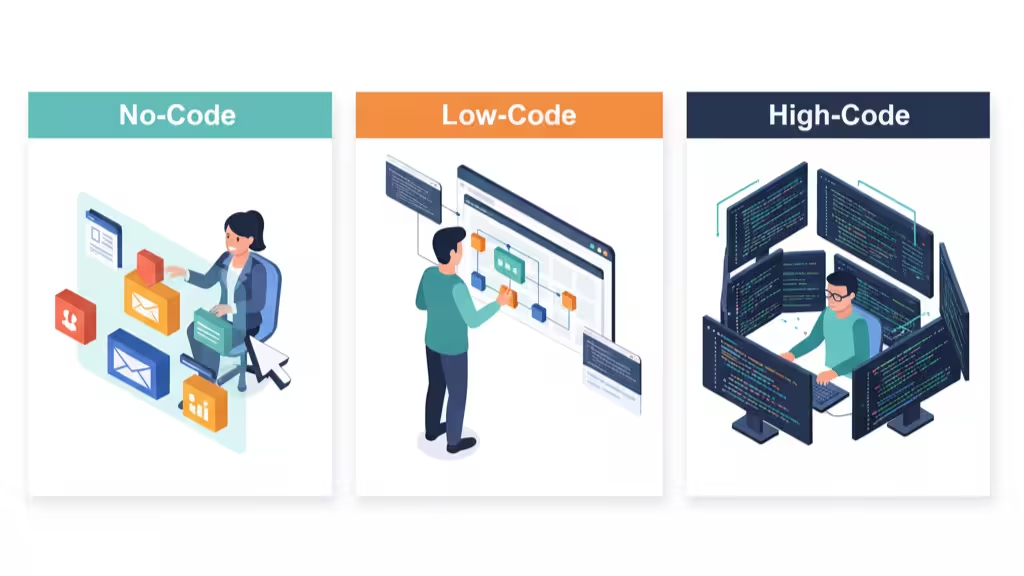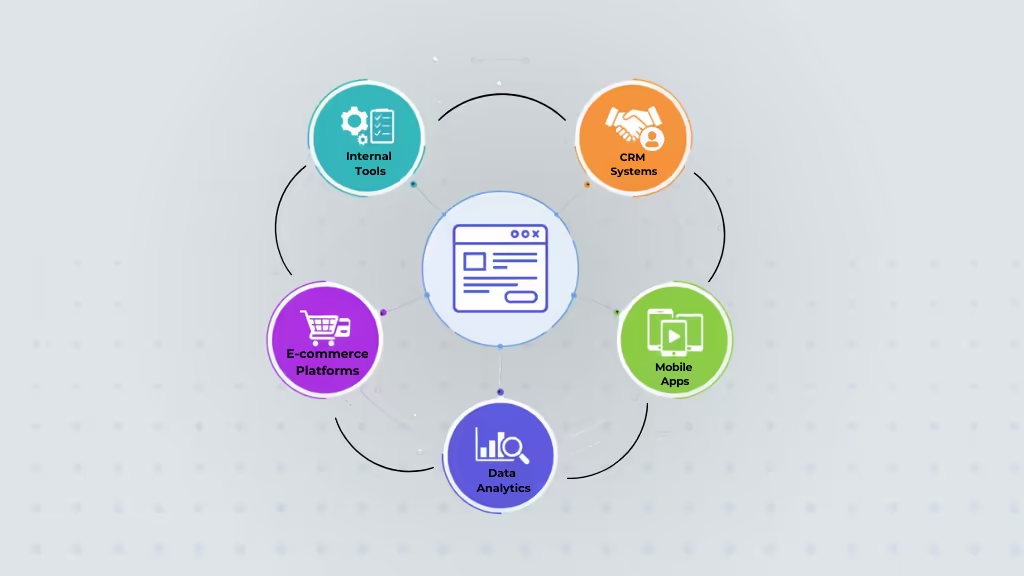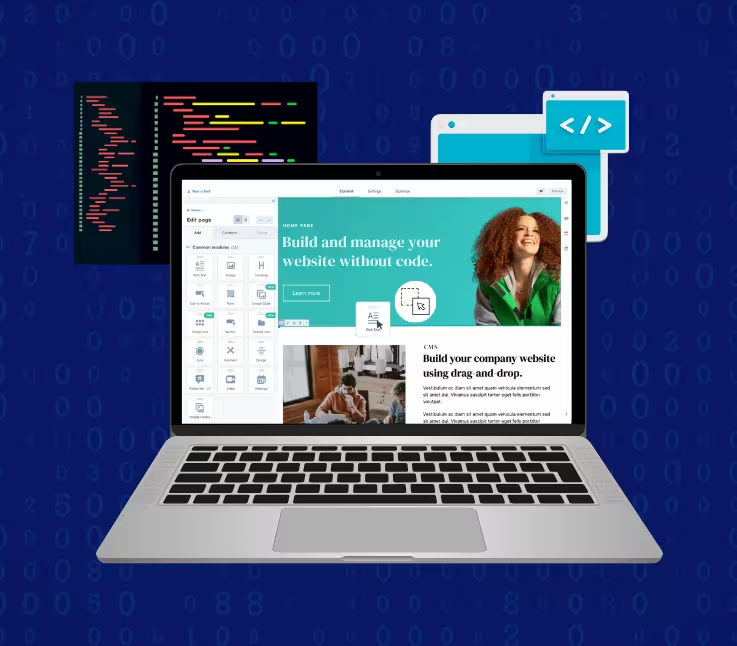- The Evolution of Low-Code Development
- How Low-Code Development Works
- Low-Code vs. No-Code vs. High-Code: What’s the Difference
- What Are the Core Features of Low-Code Platforms?
- How Can Low-Code Development Benefit Business?
- Low-Code Challenges: What to Watch Out for Before You Dive In
- How to Choose the Right Low-Code Platform
- What Types of Apps Can You Build with Low-Code Development?
- Why Low-Code Development Works Across These Applications
- How Low-Code Development Changing the Future?
- Frequently Asked Questions (FAQs)
- Conclusion
When you think about software for your business, you probably picture the big systems, your website, accounting tools, HR platform, or customer management system. In the past, building these kinds of applications required expert developers, long timelines, and significant budgets.
But times have changed.
Low code development is transforming how businesses create software. With intuitive visual interfaces and simple drag-and-drop functionality, anyone, from developers to non-technical team members, can now design and launch powerful applications in days instead of months.
It’s faster, more affordable, and sparks innovation across every level of your organization. Whether you’re a startup racing to market, an SME streamlining operations, or an enterprise driving digital transformation, low-code development empowers you to build smarter, move faster, and stay ahead in today’s fast-paced digital world.
The Evolution of Low-Code Development
The roots of low code development trace back to early rapid application development (RAD) tools and workflow automation platforms. Over the past decade, low code has evolved into a mature ecosystem supporting enterprise-grade security, scalability, and governance.
Today, it stands at the heart of digital transformation strategies, allowing businesses to rapidly deliver solutions while maintaining IT oversight and architectural integrity.
What Is Low Code Development?
Low code development is a modern, visual approach to software creation that minimizes manual coding through drag-and-drop tools, model-driven design, and reusable components. It empowers professional developers and business users alike to build applications faster and more collaboratively, bridging the gap between business needs and IT delivery.
Unlike traditional hand-coding, low-code platforms abstract much of the complexity behind application development. Instead of writing thousands of lines of code, developers design applications visually, integrating logic, workflows, and data connections through graphical interfaces.
The result? Faster delivery, lower costs, and broader participation in app creation, fueling digital transformation across industries.
How Low Code Development Works
So, how does low coding development actually work? Let’s break it down!
At its core, low coding development simplifies traditional software creation by replacing long lines of complex code with visual building blocks. Instead of writing everything from scratch, you drag, drop, and configure components, making app development faster, easier, and far more accessible.
Here’s how it typically works:
1. Visual Interface
Low code platforms provide an intuitive, drag-and-drop interface that lets you visually design your app’s structure, from user interfaces to workflows. No need to dive deep into syntax; you can literally see your app come to life.
2. Pre-Built Components
You get access to ready-made templates, logic modules, and integrations (like databases, APIs, and authentication systems). This saves tons of time and ensures reliability since these components are already tested and optimized.
3. Customization with Code (When Needed)
Even though it’s “low code,” you can still add custom code for advanced functionality. This gives you the best of both worlds, speed and flexibility.
4. One-Click Deployment
Once your app is ready, you can quickly deploy it across multiple platforms (web, mobile, or cloud) with just a few clicks. Continuous updates and integrations are also easier to manage.
Low-Code vs. No-Code vs. High-Code: What’s the Difference?

When exploring low coding development, it’s important to understand how it compares to no-code and high-code (traditional development). Each approach has its strengths, and choosing the right one depends on your business needs, team skills, and project goals.
| Aspect | Low Code Development | No-Code Development | High-Code Development |
|---|---|---|---|
| Definition | Combines visual tools with minimal coding to build apps quickly and efficiently. | Enables non-developers to create apps using drag-and-drop interfaces without writing code. | Involves writing every line of code manually for full control and customization. |
| Who Can Use It | Developers and tech-savvy business users. | Non-technical users or citizen developers. | Experienced software engineers or developers. |
| Speed of Development | apps can be built in days or weeks. | perfect for quick MVPs or prototypes. | projects can take months or longer. |
| Flexibility & Customization | Highly flexible with some coding. | Limited flexibility due to platform restrictions. | Fully customizable. no platform limitations. |
| Maintenance | Easier to maintain with platform support. | Very easy, the platform handles most maintenance. | Requires continuous technical support and updates. |
| Best For | Businesses need agility and scalability. | Simple apps, automation tools, and internal forms. | Complex, enterprise-grade applications. |
| Example Use Cases | Internal dashboards, workflow automation, and enterprise tools. | Small business apps, surveys, or lead capture tools. | Custom CRMs, eCommerce systems, and SaaS platforms. |
What Are the Core Features of Low Code Platforms?
Low-code platforms come packed with powerful features that make app development accessible to everyone, from professional developers to business users. Let’s break down the key features that make them so effective.
- Rich design tools with a wide range of ready-made templates, plus the flexibility to design your own unique app interfaces.
- Seamless API and REST integration to connect and publish web services effortlessly.
- Intuitive data handling, allowing users to view, edit, and organize even complex datasets with ease.
- Collaborative development features that let multiple developers work on the same project and resolve version conflicts quickly.
- Precision reporting and graphics tools to generate professional reports and visuals that print exactly as intended.
- Progressive web app (PWA) creation, giving your apps a native, mobile-friendly look and feel.
- Remote database access with the ability to run SQL queries securely via HTTP or REST.
- Advanced data formatting and grouping to present insights in meaningful ways.
- Reusable data reports that can be saved, refreshed, or customized on demand.
- Version control support with GitHub and other shared repositories for seamless teamwork.
- Support for diverse data types, from numbers and text to images and multimedia.
- Full SQL language access for developers who need deeper customization.
- Activity monitoring dashboards for both developers and users.
- AI-assisted development tools that offer natural language support and code suggestions.
- Smart autocomplete to enhance search and query accuracy.
- Form builders for viewing and editing database tables without manual coding.
- Built-in data encryption to safeguard sensitive information.
- Threat detection systems that identify risks like XSS or parameter tampering.
- Real-time error reporting to help troubleshoot running applications efficiently.
- Flexible extensibility, supporting custom JavaScript, SQL, or PL/SQL for advanced use cases.
- Multi-developer collaboration without the fear of overwriting or losing work.
- AI-powered chat and user dialog tools for enhanced interactivity.
- Geolocation features that ensure data sovereignty and location-based functionality.
- Globalization support for multilingual app deployment.
- Mobile integration with other native phone or tablet apps.
- Granular access control to manage user permissions, from read-only to full edit rights.
- Process workflow builders that streamline end-user tasks and approvals.
- Real-time enterprise data search for instant insights.
- Dynamic, interactive charting tools to visualize data on the fly.
- Secure authentication systems for cross-browser and mobile access.
- Shared, reusable components that can be updated with a single click.
- Comprehensive debugging and tracing tools for faster troubleshooting.
- Developer task lists and workflow approvals to improve team productivity.
- Accessibility-compliant UI components to ensure inclusivity.
- Extensive font, icon, and graphic libraries to bring visual polish to every app.
These capabilities ensure that applications built on low-code platforms are not only fast to create but also enterprise-grade in reliability, performance, and security.
How Can Low Code Development Benefit Business?
Low Coding Development steps in to give businesses a competitive edge. It’s not just about building apps faster, it’s about empowering teams, reducing costs, and driving innovation without getting tangled in lines of complex code. Here’s how low-code development can transform your business:
1. Accelerated Time to Market
Low-code platforms dramatically shorten development cycles, transforming project timelines from months to weeks. Teams can prototype, test, and iterate in real-time, ensuring faster value delivery.
2. Reduced Costs and Higher ROI
By minimizing manual coding, organizations lower development and maintenance costs. Faster delivery and fewer bugs translate into tangible ROI, freeing resources for innovation.
3. Empowered Citizen Development
Low-code empowers non-technical business users, or “citizen developers”, to create and iterate on apps within guardrails set by IT. This democratization of development fosters agility and responsiveness across departments.
4. Enhanced Collaboration Between IT and Business
Visual tools make app logic transparent, improving communication between technical and non-technical stakeholders. The result is a shared understanding of business needs and faster alignment on solutions.
5. Scalability and Future-Readiness
Modern low-code platforms scale seamlessly to support increased users, data, and functionality. This flexibility helps enterprises stay future-ready as business requirements evolve.
6. Increased Agility and Innovation
By reducing technical barriers, low-code allows teams to experiment and innovate faster, driving continuous improvement and rapid adaptation to market shifts.
7. Improved Customer and Employee Experience
With faster iteration cycles and real-time feedback, organizations can deliver user-friendly applications that improve engagement, satisfaction, and productivity.
Low-Code Challenges: What to Watch Out for Before You Dive In
While low-code development is transforming how businesses create software, offering speed, cost-efficiency, and accessibility, it’s not a silver bullet. Like any technology, it comes with its own set of challenges that you’ll want to consider carefully. Let’s break them down in a clear, conversational way:
- Complex Maintenance: Dynamic business logic and integrations can increase complexity over time.
- Governance Gaps: Without proper oversight, uncontrolled citizen development can create shadow IT risks.
- Integration Limitations: Connecting to legacy systems or proprietary APIs may require technical intervention.
- Limited Customization: Some niche features may exceed the visual editor’s capabilities.
- Vendor Lock-In: Proprietary frameworks may restrict portability across platforms.
How to Choose the Right Low-Code Platform
So, you’ve decided to embrace low coding development, great choice! But with so many platforms available, finding the right one can feel overwhelming. Don’t worry, choosing the best low-code platform for your business doesn’t have to be complicated. Here’s how you can narrow it down smartly.
1. Understand Your Business Goals
Before diving in, get clear on why you’re adopting low coding development.
- Are you looking to build apps faster?
- Do you want to automate workflows?
- Or maybe you need to empower non-technical teams to create tools independently?
Knowing your goals will help you match the platform’s strengths with your actual needs.
2. Check Ease of Use and Flexibility
The main advantage of low coding development is simplicity, so your chosen platform should offer:
- A drag-and-drop interface
- Pre-built templates and components
- Easy integration with existing tools (like CRMs, ERPs, or cloud services)
If your team can quickly learn and build with it, you’ve found a winner.
3. Prioritize Security and Scalability
As your applications grow, so will your data and user base. Look for platforms that:
- Offer robust data protection and user access controls
- Support scalability to handle future growth
- Comply with industry standards like GDPR or ISO
Security and scalability aren’t optional, they’re essential for sustainable development.
4. Evaluate Integration Capabilities
Your low-code platform should play nicely with other systems. Ensure it can:
- Connect with popular APIs
- Sync data across multiple platforms
- Work with both cloud-based and on-premises environments
Smooth integration helps you get more value from your existing tech stack.
5. Compare Pricing and Support
Finally, compare costs and support options. Some platforms charge per user, while others use subscription models. Also, check if the provider offers:
- Customer support and training resources
- A strong community for troubleshooting and inspiration
Remember, the cheapest option isn’t always the best, focus on long-term value.
What Types of Apps Can You Build with Low Code Development?

One of the most exciting aspects of low code development is its versatility. With the right tools, you can create a wide range of applications, even if you don’t have extensive coding skills. Whether you’re building simple apps for internal use or more complex customer-facing platforms, low-code platforms make it easier than ever to bring your ideas to life. Here are some types of apps you can build with low-code development:
1. Internal Workflow and Process Automation Tools
Low-code platforms are perfect for automating internal workflows and improving business processes. You can quickly design apps to streamline repetitive tasks, manage data flows, or automate approval processes without needing a team of developers. Some common examples include:
- Task management apps
- Employee onboarding systems
- Inventory tracking tools
2. Customer Relationship Management (CRM) Apps
Want a tailored CRM without the hefty price tag of custom software? Low code platforms let you create personalized CRM solutions that cater to your business’s unique needs. You can manage customer interactions, track sales, and organize your contacts in just a few clicks.
3. Data Collection and Reporting Apps
If you need apps to gather and analyze data, low code development makes it super easy. You can build tools to collect feedback, survey responses, or project data, and generate reports in real time. It’s ideal for:
- Survey platforms
- Custom reporting dashboards
- Analytics apps
4. Customer-Facing Web and Mobile Apps
Low-code isn’t just for internal tools. You can also design stunning, customer-facing web and mobile apps. Whether you’re launching an e-commerce site, booking system, or service platform, low-code platforms provide the flexibility to create apps that are user-friendly and scalable. Think of:
- Online booking systems
- E-commerce stores
- Event registration apps
5. Mobile Applications
In today’s mobile-first world, building mobile apps with low code development is a game-changer. These platforms allow you to quickly design and deploy mobile apps for both Android and iOS, without the need for deep native development expertise. You can create:
- Customer service apps
- On-the-go project management tools
- Employee communication apps
6. Enterprise Applications
For large businesses looking to integrate complex systems, low-code platforms can help bridge the gap between different departments or software tools. You can connect your various systems and create custom solutions that help departments work more efficiently. Some ideas include:
- Inventory and supply chain management
- HR and payroll systems
- Financial management tools
Why Low Code Development Works Across These Applications
What makes low code development so effective for all these types of apps is its speed and flexibility. You don’t need to start from scratch or rely on long development cycles. You can quickly prototype and iterate, making adjustments as you go. Plus, many low-code platforms offer pre-built templates, integrations, and automation tools to make your job even easier.
No matter what kind of app you’re building, low-code development offers a simple, cost-effective solution to turn your ideas into reality. Whether you’re improving internal processes or launching customer-facing apps, low-code gives you the power to innovate at your own pace.
How Low Code Development Changing the Future?
The next phase of low-code development will be defined by convergence with emerging technologies and deeper enterprise integration.
1. AI-Assisted Development
Artificial intelligence is already transforming low-code platforms using vibe coding, from natural language app design to predictive debugging and automated testing.
2. Hyper-automation
Low-code is increasingly integrated with robotic process automation (RPA), workflow orchestration, and AI analytics, creating an ecosystem of continuous automation and insight.
3. Citizen Development at Scale
Organizations are formalizing citizen developer programs, training business users, and establishing governance frameworks to safely scale innovation across teams.
4. Cross-Platform and Context-Aware Apps
Expect broader support for offline access, multi-device responsiveness, and context-aware experiences that adapt dynamically to user behavior.
5. Platform Maturity and Ecosystem Growth
The low-code market will continue to mature, with platforms offering richer developer ecosystems, industry templates, and cross-cloud portability.
Conclusion
Low-code development has redefined how software is conceived, built, and deployed. By combining visual design with robust governance, it empowers both IT teams and business leaders to collaborate and innovate faster than ever before.
As digital transformation accelerates across every industry, low-code platforms stand as a strategic enabler, turning ideas into applications at the speed of business.
Whether you’re an enterprise CIO, a developer, or a business analyst, embracing low-code development means unlocking a future where creativity, speed, and technology move in sync.
Frequently Asked Questions (FAQs)
Curious about low code development? In this section, we answer common questions to help you understand how low-code platforms can benefit your business. Whether you’re just starting out or ready to implement, we’ve got the answers you need.
Q1. Can I build production-grade applications using low-code platforms?
Yes. Modern low code platforms support enterprise-grade performance, scalability, and compliance.
Q2. Do I need to know how to code?
Not necessarily. While citizen developers can build simple apps visually, more complex use cases may require light coding for integrations or customization.
Q3. Are low-code apps secure and compliant?
Leading platforms offer built-in security controls, audit trails, and compliance certifications. However, governance and configuration remain critical.
Q4. Will low-code replace traditional developers?
No, it complements them. Developers can focus on complex, high-value logic while low-code accelerates delivery and empowers business teams.
Q5. How does low-code accelerate digital transformation?
By enabling rapid innovation, reducing IT backlogs, and fostering collaboration, low-code helps organizations modernize systems faster and respond to changing market needs.
This page was last edited on 23 October 2025, at 11:50 am
How can we help you?
























